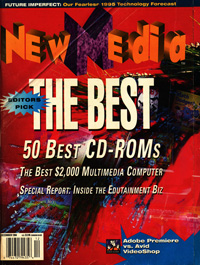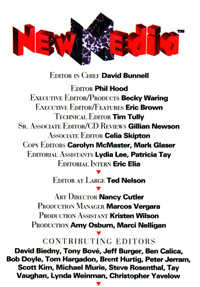|
Vaughan Family Timestream® Maps |
| Home Biography People Places Multimedia: Making It Work On the Water Writings/Presentations |
Ask the Captain
July, 1993
From "Ask the Captain," a monthly column by Tay Vaughan.
New Media Magazine.
Q. Dear Tay: I just read your answer to Patrick Dillon's question in your column for March, 1993. My response is difficult to contain: "Aaarrrrggghhhh!!!! You Ignorant Slut!" Ok, perhaps I am overreacting, but you are refusing to let go of linearity. Why ever do you want to "constrain the combinatoric explosion of narrative pathways" in interactive fiction? Good Lord, that's what makes the gametree bushy. This is exactly the kind of work that's well-suited for a computer to perform -- grinding out three billion story variations!
-- Chris Crawford, San Jose, CA
A. Chris, I've been called a lot of things over the years (like Fay and Ray), and it's with a smile that I add your gift to my collection, seeing in my mind's eye Jane Curtain's sorely-missed Saturday Night Live presence at the receiving end of the invective! Well, never mind.
Your challenge represents a serious and heady subject for multimedia designers today. When a plot is broadly non-linear, the permutations of events and possible outcomes become staggering, and the story as a whole becomes difficult to visualize and manage. Producing such work is also an intellectual challenge and costly in time and effort, even while awakening the "power" of computer-based multimedia literature. Interactive stories with too few branches are disappointingly flat and shallow.
Your interesting "algorithms for interpersonal behavior, personality models, artificial personality, languages of expression, and facial displays" represent, perhaps, a successful marriage of this computer power with literature contianing maleable plots and seemingly endless variations. Indeed, your forthcoming (1994) epic game, Le Morte D'Arthur, will surely break new ground and quite possibly prove your point. Can't wait to get a copy!
But a truly open-ended "hypermedia" navigation system for consumer consumption risks death by shock caused by open arterial branches and loss of story pressure, where plot lines become too diffuse and users founder in trivia. Most users may, indeed, prefer a structured, organized, and well-defined story environment.
The argument for simplicity is voiced by Steven Levy, another well known computer-literate creator (Hackers and Artificial Life), who succinctly offers "There's really something to be said for documents with a beginning, middle, and end."
The shape of this new literature made possible by multimedia computers, CD-ROM, and wide-bandwidth cable and telephone delivery systems is at this very moment being born in the working designs of developers. The final test for succesful multimedia design is the marketplace, where consumers will decide one approach is better than another.
---
Q. We have decided to make CD games for PC and CD-I. We would like to know which book(s) talk about game design (action, RPG, graphic adventure, etc.). Yours faithfully,
-- LAM Chi-fung, North Point, Hong Kong
A. For an excellent summary of basic concepts and techniques try Computers as Theater by Brenda Laurel (Addison Wesley, 1991, ISBN 0201510480).
A subscription to The Journal of Computer Game Design (5251 Sierra Road, San Jose, CA 95132) will keep you current. It's editor is, incidently, Chris Crawford (see above).
As you mention CD-I as one of your proposed development platforms, you might also contact Jo Ann Campbell, Administrative Manager of the CD-I Association of North America (11111 Santa Monica Blvd., Suite 700, Los Angeles, CA 90025. 310-444-6613). With a $95 Associate Membership you receive a Producer's Handbook for CD-I and a quarterly newsletter; for a $295 Individual Membership, you will also receive the Technical Notes - tips and recommendations for design, authoring, and production.
---
Q. I am a multimedia user who is looking for ways to further integrate digital music with computer graphics. Specifically, I want to be able to control Macromind Director cast members via MIDI notes triggered on a synthesizer or software sequencer. For example, every time an F# note is played on the keyboard or sequencer, it would trigger a color change or move the desired cast member. Is this possible using the lingo scripts in Director? If not, is there a way to write a script that would link an external command?
David Fortner, Livermore, CA
A. This is neat stuff. Because MIDI can control not only music and audio events but also such external resources as an entire theater's lighting system, you could "play" a complete show on your keyboard, including the big-screen computer projection in Director! As far as I know, the only XCMD that allows you to input MIDI commands into Director and HyperCard is HyperMIDI (available for about $130 from EarLevel Engineering at 310-316-2939). To go the other way -- that is, to click on a sprite in Director and play a MIDI file or cause an external MIDI-activated event to occur, OpCode Systems' (415-856-3333) $39.95 MIDI playback XCMD offers terrific control.
The Macintosh does not come with built-in MIDI capability, so you must spend some time and effort getting your MIDI system set up and your instruments routed properly. If you are using several instruments and a multiport interface, you will need the OMS software package from OpCode and Apple's MIDI Manager to make it work.
In San Francisco, Zakros InterArts provides on-going technical classes in multimedia and electronic music with emphasis real-world tricks and techniques. Call 415-282-5497 for a schedule.
---
Send your questions to TAY c/o NewMedia, 901 Mariner's Island Blvd., Suite 365, San Mateo, Calif. 94404 or send a fax to (415) 573-5131. Writers of published questions will receive a NewMedia T-shirt and prompt answers to their questions. Tay is president of Timestream, Inc,. a CD-ROM and multimedia title production and publishing company, and is author of Multimedia: Making It Work, (Osborne/McGraw-Hill).

